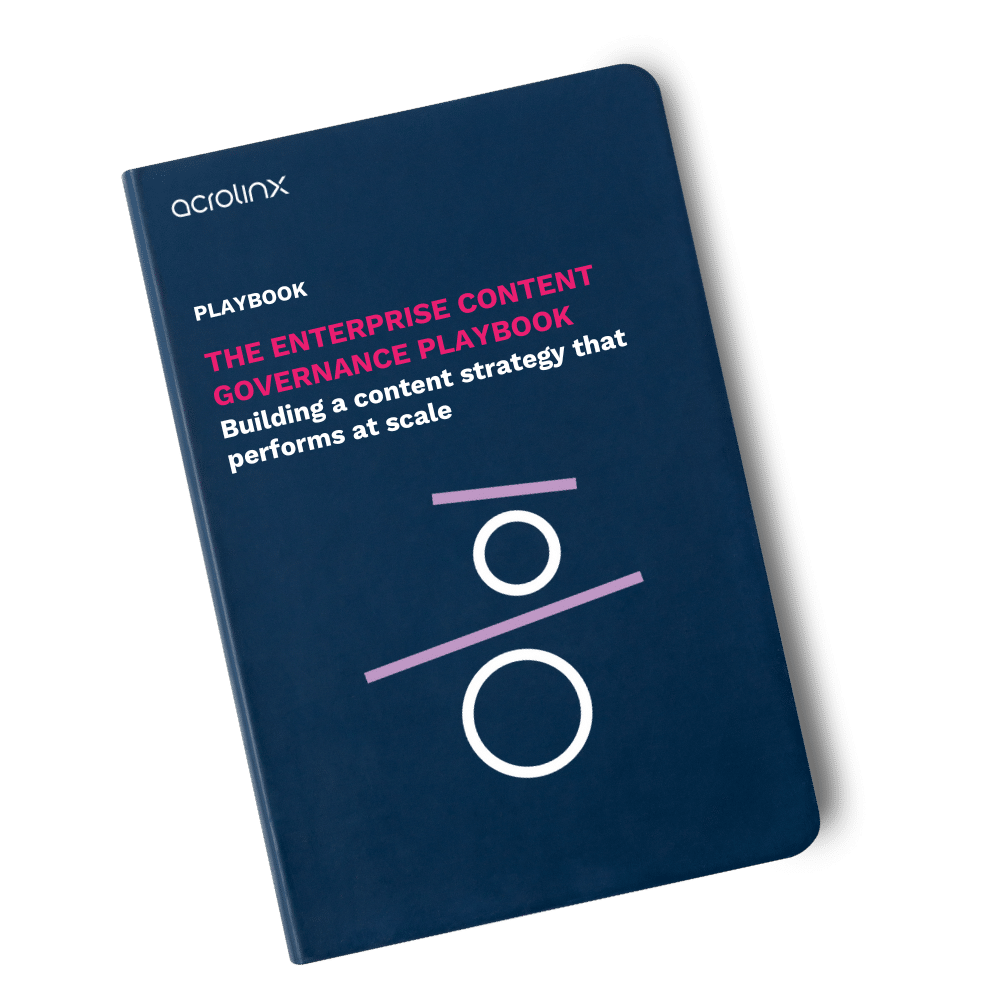Creating Relevant Content begins with a Rock-Solid Content Governance Plan

Creating impactful content enterprises means publishing content that’s truly meaningful to your audience. To reach this goal, make sure your strategy focuses on avoiding content waste. To explain what we mean by “content waste”, we’d like to introduce the metaphor of vintage fashion.
Content lessons from vintage clothing
Clothing trends that go out of fashion eventually come back into style. Just ask your parents! The great thing about “vintage” making a come-back is that fewer new resources enter the supply chain. The more we reuse quality-made clothing, the less waste we create.
Vintage styles stay in fashion because they’re either classic, evergreen pieces or they’re so well made they’re practically indestructible. Why is so much clothing thrown away and not donated to charity or second-hand shops?
Every second of every day, the equivalent of a rubbish truck full of clothes ends up on landfill sites around the globe. Yes you read that correctly. Every second. In America alone, an estimated 11.3 million tons of textile waste – equivalent to 85% of all textiles – end up in landfills on a yearly basis. Fast fashion serves the purpose of either being cool or functional for a limited time. But its quality doesn’t allow you to wear it for years.
What content experts can learn from fashion
Some companies use environmentally friendly products and processes for their apparel. For instance, they reuse materials. The final products are also often meant to be very durable, which allows you to wear them over a long time. As it turns out, we can learn a lot from the principles of sustainable fashion, when it comes to enterprise content. This is especially true when it comes to waste.
Avoid content waste
Creating content for content’s sake leads to content waste. Sounds like a harsh hypothesis? Yes, but it’s true. According to SiriusDecisions, more than 60% of B2B marketing content is produced, but never used. And that’s because it’s either been created with no purpose or based on guesstimates only.
The critical point is the moment your audience consumes your content. Can you tell how effective – and more: how impactful – your content is? If not, every new asset is just based on guesses, on estimated customer needs. You risk wasting your resources (your content creators’ time) by producing new content without knowing if it’s what your audience needs.
To avoid wasting resources and producing content waste:
- Implement content governance to get insights on how impactful your content is.
- Improve bad content – reuse good content.
Content governance is important
Content governance is the complete opposite of content guesses and creating content for content’s sake. Content governance starts with a content strategy that has clear goals for your content.
What do you want to accomplish with your content? Whom do you want to reach? Your content goals define how content has to be written to be impactful. Then, you have to set up the appropriate language to reach those goals.
Start writing long lasting content that’s relevant to your audience and make sure you’re compliant with your goals.
Tip: Already using content KPIs? If not, start doing so!
Tips for greater content impact
| Content impact definition: All enterprise content has a purpose and an expected outcome. Deeper engagement, higher conversions, fewer support tickets — to name a few. When your content possesses the qualities it needs to meet those results, it’s fit for purpose and will provide a positive experience. Understanding the relationship between the quality of your content and its performance is how you determine its impact. Fit, strategy-aligned content performs well and has a positive impact on your audience. |
Here are a few pointers to create content with greater impact.
Set content quality thresholds
Set thresholds to align all your writers to unified content quality standards. The Acrolinx content impact platform can help you here, as it allows you to configure content goals for all your teams and check content against those goals. Comprehensive analytics always provide an overview on how your content is performing. They also show you where you might need to refine the guidance for your writers. This way, only great content leaves your enterprise.
Combine qualitative and quantitative KPIs
Another KPI tip: Combine Acrolinx’s content analytics with quantitative performance metrics such as Google Analytics. No need to do this manually: Our Content Cube feature is here for you.
Keep an eye on your analytics
Make sure to always have an overview of your content analytics and the way people interact with your content. Meaningful content without content governance is a paradox.
Don’t discard content: Improve, repurpose, and reuse
What happens to legacy content that existed before you implemented content governance? Or the content that was written with the best intentions, but didn’t yield the results you expected? You have two possibilities: Toss it or improve it.
While the first option creates content waste, improving it makes sure your content remains in the content lifecycle. Speaking in supply chain metaphors, it’s fed to the content supply chain to build a more compelling product.
Technology not only allows you to improve your content as you create it, but you can also batch-check existing content to find out which pages need help.
For each great content piece, either newly created or improved, our advice is: reuse it! An example is, if you create modular content, improve your modules and then reuse the improved copy for future assets.
Reuse is efficient because it saves your writer’s time. But it’s also an efficient way to create new content, since writers don’t have to produce everything from scratch. Plus: By reusing already approved content, you avoid creating new content waste.
Create relevant, long-lasting content
How do you build relevance in content? To make your content relevant, start by understanding your audience—what they care about, their challenges, and the information they need. Use research, surveys, and analytics to tailor your content to their interests. When your content directly solves problems or provides valuable insights, it naturally becomes more engaging and useful.
Staying current with industry trends, news, and regulations is also key. Referencing recent developments, authoritative sources, and expert opinions keeps your content fresh and credible. Search optimization (SEO) helps ensure your content is easily discoverable, so use the right keywords and structure your content in a way that makes it easy to read and navigate.
AI tools like Acrolinx can help maintain consistency, improve clarity, and ensure compliance in your writing. But it’s equally important to keep a human touch — writing in a conversational, engaging tone rather than sounding robotic. Encouraging interaction through questions, comments, or calls to action also makes your content more dynamic.
Finally, don’t let your content go stale. Regularly update older pieces with new data and insights, and repurpose your best content into different formats, like videos, infographics, or social media posts. This keeps your message relevant across multiple platforms and maximizes its reach.
Strategic content development allows you to waste fewer resources and create meaningful content for your intended audience. Therefore, you need enterprise-wide content governance. Learn more about this topic here. Or schedule a demo to see how Acrolinx can help you create impactful content that matters.
Frequently asked questions
Tailor content to audience needs and search intent. Acrolinx helps by aligning tone, terminology, and clarity to reader expectations.
Continuously review for clarity and accuracy. Acrolinx identifies outdated or misaligned content and provides suggestions for improvement.
Relevant content drives engagement, trust, and conversion. Acrolinx makes sure it resonates with target audiences and meets regulatory standards.
Compare content quality scores with engagement metrics. Acrolinx provides content quality insights and allows tracking them over time.
They quantify the impact of governance, tracking improvements in quality, compliance, and audience engagement. Acrolinx enables KPI reporting.
Are you ready to create more content faster?
Schedule a demo to see how content governance and AI guardrails will drastically improve content quality, compliance, and efficiency.

Hannah Kaufhold
is a Senior Marketing Manager at Acrolinx, with over ten years experience in content strategy and content creation. They hold a Master’s degree in linguistics. Hannah has a strong interest in controlled languages and terminology and is passionate about diversity and inclusion. In their free time, they enjoy spending time with their family and reading.





